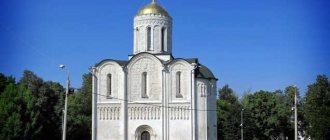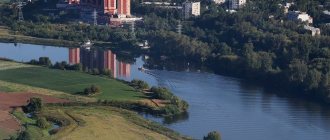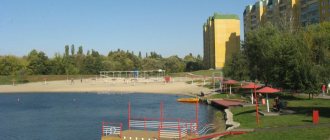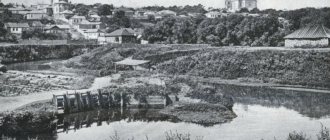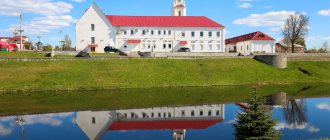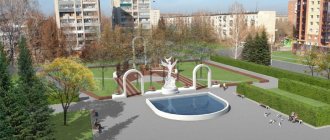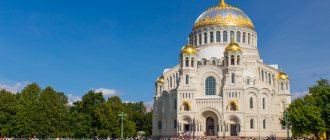Countries > Russia
Uglich is an ancient city on the banks of the Volga, known since the 10th century. It was burned during the Tatar-Mongol and then Polish invasions, so most of the surviving historical monuments date back to the 17th-18th centuries. It is quite popular among tourists, as many come here as part of a trip to the Golden Ring or the Yaroslavl region. The historical center is located quite compactly, which allows you to feel the atmosphere of a historical Russian town and mentally transport yourself several centuries ago.
- Uglich Kremlin
- Transfiguration Cathedral
- Chambers of appanage princes
- Church of Demetrius on the Spilled Blood
- Trade area
- Church of the Nativity of John the Baptist
- Korsun Church
- Epiphany Monastery
- Pereslavtsev House
- Resurrection Monastery
- House of the Evreinovs
- House of Tugarinovs
- Zimin's yard
- Volzhskaya embankment
- Interesting places
- How to get there
- Map
In the center
Kremlin
The oldest place, as in many ancient Russian cities, is the Kremlin. The first wooden defensive fortifications appeared along with the foundation of Uglich, and in the 17th century they were replaced by stone walls. However, these walls did not survive either, since a century later they were dismantled as unnecessary. Their approximate location can be guessed from the ditches.
The Kremlin played an important role during the heyday of Uglich in the 15th century, when it became a military and administrative center. In those years, a cathedral, a garrison and a chamber of appanage princes were built inside, only the last of which survived. At the same time, the layout of the main streets, fanning out from the square, was thought out. All of them turned into roads leading to neighboring Yaroslavl, Rostov and Moscow.
On the territory of the Kremlin, only civil and religious buildings from completely different eras have been preserved: two churches, the Princely Chambers and the Duma. Entrance to the Kremlin is free, but to get a sense of the ancient history of this place, it is better to visit it along with a tour.
Transfiguration Cathedral
The first thing that catches your eye when visiting the Uglich Kremlin is the five-domed Spaso-Preobrazhensky Cathedral. It was built in the 18th century on the site of an older temple from the 13th century, which was burned during the Polish invasion. At the same time, a four-tier bell tower was completed.
Compositionally, the cathedral is made in a typical Yaroslavl architectural style, while the decor is eclectic and belongs to the Naryshkin baroque and classicism. Previously, the central square was located in front of this cathedral. It’s definitely worth going inside, as the interior, painted with impressive frescoes on the theme of the New Testament, and the iconostasis deserve attention.
st. Kremlin, 5
Chambers of appanage princes
The princely chambers of the 15th century miraculously survived the Polish invasion, when all the Kremlin buildings were burned. Princes lived in the chambers for many years, and since the 19th century, a museum composition has been located inside, telling about the history of the principality. Despite the fact that the chambers were rebuilt more than once, they remain a unique architectural monument of ancient Russian architecture and one of the oldest civil buildings in Russia. It is worth paying attention to the painting of the image of the Savior Not Made by Hands on the southern wall.
st. Kremlin, 4
Monument to Tsarevich Dmitry
A few years ago, a monument to Tsarevich Dmitry was unveiled in front of the chambers, made in the image of Nesterov’s painting.
Church of Demetrius on the Spilled Blood
The church was erected on the site of the murder of Tsarevich Dmitry Uglitsky, the son of Ivan the Terrible. This dramatic event is considered the catalyst for the political crisis that began the Time of Troubles. One version is that Boris Godunov ordered the murder of the prince, but the circumstances and reasons remain unclear to this day. In particular, Pushkin’s tragedy “Boris Godunov” is dedicated to these events.
The church was built a few years after the murder in the 17th century, and its red color symbolizes the blood of the murdered man. By the way, Uglich has one of the most unusual coats of arms of Russia - it depicts Tsarevich Dmitry with a knife in his hand on a blood-red background.
st. Kremlin, 3
Trade area
Now the main city square is located right in front of the Kremlin and is called Torgovaya. Its appearance has changed a lot over the past few centuries. Once upon a time, the architectural composition consisted of four churches and shopping arcades. During Soviet times, three churches were demolished as part of the anti-church campaign, and only one remained - Kazan. Some of the classic-style shopping arcades can still be seen today, and the premises are still occupied by various shops. Holidays, concerts and fairs are usually held on the square in front of them. The main streets diverge from here: Rostovskaya, Grazhdanskaya, Lenina, Pervomaiskaya.
Shopping arcades
The rows are practically the only thing that has survived from the original architectural ensemble of the square. Most of the buildings burned down in a fire, so the original appearance of the square can only be judged remotely. The rows were built for trade and warehouses, and are still in use today. The modest but elegant project is reminiscent of the rows in Kostroma.
The shopping arcades are reminiscent of the heyday of the merchant class of the 19th century. Fairs were regularly held here, trade shops and craft workshops were built. Trade took place with neighboring large settlements, St. Petersburg and Moscow.
It is noteworthy that most of the money that came to the treasury in the form of trade excise taxes was spent on charity, the creation of shelters, hospitals and almshouses. Many local merchants were philanthropists and donated a significant portion of their income to help the poor. Also, with their money, an important city monument, the Chamber of Appanage Princes, was restored, and a museum of domestic antiquities was built inside.
Uspenskaya Square, 3
Church of the Nativity of John the Baptist
This church is convenient to visit when walking along the Volga from the Kremlin to the Uglich hydroelectric power station. It was also built in the 17th century in accordance with Yaroslavl architectural traditions with many decorative details and tiles. The order for construction came from a wealthy merchant in memory of his six-year-old son who died at the hands of the clerk. In the 1960s, during restoration, a niche with his burial was discovered in one of the chapels of the temple.
The temple is located in close proximity to the hydroelectric power station. According to the original plan, this area should have been flooded after the construction of the station. Surprisingly, even in Soviet times, when many religious buildings were destroyed, the cultural value of the temple turned out to be high, and the construction site of the hydroelectric power station was moved higher up the river in order to preserve it.
Spasskaya st., 14
Brief history of Uglich
The first settlements on this site were already in the 5th century. There are two main versions about the name of Uglich:
- in the past, coals were burned here;
— the Volga River makes a corner in this place.
The city of Uglich was founded in 937 by Jan Pleskovitich, a relative of Princess Olga. Since 1218, Uglich was the center of the principality of the same name. In 1238 it was burned by the Mongol-Tatars, but already in 1261. began to rebuild. In 1328 it was annexed to Moscow.
In 1371, Metropolitan of All Rus' Alexy founded the Assumption (later Alekseevsky) Monastery here. In the 15th century, many stone buildings were created: the cathedral, the Intercession Monastery (destroyed during the construction of the Uglich hydroelectric station), the chambers of the princes, which have survived to this day.
On May 15, 1591, Uglich became known throughout Rus'. It was on this day that the heir to the throne, the son of Ivan the Terrible, was killed here. About 200 people were executed on suspicion of involvement in this crime, but the main culprit of the tragedy (read: the customer) was never found.
At the beginning of the 17th century, the city grew greatly and, taking into account the surrounding area, had 3 cathedrals, 150 parishes and churches, 12 monasteries, up to 17,000 tax households and about 40,000 inhabitants. It was divided into 3 parts: the fortress (surrounded by a moat), the city itself and the Streltsy settlements.
On August 31, 1778, the coat of arms of Uglich was established.
By the end of the 19th century, the city began to decline, as the lack of railways hampered the sale of industrial and agricultural products.
Alexandre Dumas visited here in 1858. Later M.E. visited the city. Saltykov-Shchedrin, A. Ostrovsky, V. Zhukovsky, I. Surikov, I. Grabar, N. Roerich and other artists.
In 1939, the Uglich reservoir was created. In 1935-1950, the Uglich hydroelectric power station was built.
Source
Unusual places
Uglichskaya HPP
The Uglich hydroelectric power station is not only an industrial facility, but also a monument of the era. The station began construction in the 1930s and was put into operation in 1940, making it one of the oldest hydroelectric power plants in Russia. The main buildings are designed in the style of Stalinist classicism. On the left bank of the Volga there is a shipping lock through which ferries and ships pass.
The hydroelectric power station generates a lot of electricity and is of great strategic importance, but the consequences of its creation were the flooding of several cities. The most famous of them are Kalyazin and Mologa, where architectural monuments were destroyed and thousands of people were displaced.
Flooded Volga cities Places flooded during the construction of the Uglich hydroelectric power station, and what they look like now.
Read more
Hydropower Museum
Not far from the hydroelectric power station itself there is a museum of the history of hydropower in Russia. There are many interactive exhibits here, the principles of operation of hydroelectric power plants are explained, the difficulties of their construction and the prospects for the development of the region in the country are described.
Spasskaya st., 33
Shipping lock
At the entrance from Myshkin, you will definitely pass the shipping lock of the hydroelectric station, through which all ships traveling along the Volga pass. In ten minutes, the water in a ten-meter passage descends and rises in about the same time. There is an elegant arch above the gateway, and from this place there is a panoramic view of the coast.
Museum of Prison Art
The Forbidden Zone Museum displays exhibits collected from various prisons. What is striking about the exhibits is the ingenuity and skill with which they were created using only scrap materials available in the prison. Among them are icons, weapons, musical instruments and sculptures.
st. Olga Berggolts, 1
Dead-end railway Uglich-Kalyazin
For a long time, the Uglich region was cut off from large settlements, and was connected only by small roads and shipping. Talks about building a railway began back in 1905, but then the Russo-Japanese War prevented the project from being implemented. Residents of Kalyazin have repeatedly petitioned for the creation of a road, since getting here was quite problematic. Under the conditions of the First World War, the Revolution and the Civil War, all projects continued to be postponed.
Construction began only in 1937, when the creation of the Uglich hydroelectric power station required the transportation of a large amount of building materials. Now the railway connects the station with Savelovo, passing by Kalyazin. There are currently two carriages in this direction: reserved seat and seated, although the journey is only 2.5 hours. The road goes through dense forests, sometimes the Volga can be seen through the trees.
Puppet Museum
In addition to numerous temples and cathedrals, there are many other interesting places in Uglich that you should definitely visit. Traveling with children? In this case, visit the doll museum, which is located on Olga Berggolts Street, 1/2.
Olga Pavlycheva offers amazing exhibitions of various dolls made from fabric, paper, dough, papier-mâché. The author spends several months on the production of some exhibits. The exhibition features about a hundred dolls: playful, offended, laughing, mischievous, serious. In addition to visiting the museum, you can buy your child a doll he likes.
Streets
The city center has been well preserved; on some streets it may even seem that almost nothing has changed in a couple of centuries. Of course, there is no hectic life here, but there are good cafes and hostels, and due to its compactness, the city is perfect for a one-day trip. The most atmospheric area is near the Church of John the Baptist, and the most atmospheric outlying areas are near the railway station.
Uglich – Russia
The city of Uglich was founded around 937 and has a rich history. Over 1000 years, many cultural, architectural and religious monuments have been created, some of which have survived to this day and can tell about Russia’s past.
Where to stay
Accommodation prices are quite low in Uglich, but the place we stayed in was the best in terms of price-quality ratio. This is a hostel where we booked a private room. Apparently it opened recently, because the furniture, showers and all appliances were new. We liked that it was very clean, quiet and cozy, and the best location was in the very center right next to the Volga. Therefore, I share a recommendation: Hostel in Uglich. The most convenient way to book it or choose other options is on Hotellook.
Popular message topics
- Amethyst Amethyst is a beautiful purple colored gemstone. From ancient Greek its name is translated as “non-intoxicating stone.” There are several legends telling about the origin of the stone. Here is one of them.
- Frog Scientists classify frogs as tailless amphibians. That is, these are animals that can live both in water and on land. In total, there are more than 500 species of frogs. They live everywhere, all over the earth, except the far north. Most of them are found
- Ballet Ballet is a very subtle, beautiful and aesthetic theatrical art. Ballet originated in Italy in the mid-sixteenth century. The name ballet comes from the Italian word “ballo”, which means dance. At first the ladies danced on stage in long dresses,
How to get there
Uglich is easily accessible from all cities of the Yaroslavl region by bus. The bus takes 3 hours from Yaroslavl, and about an hour from Rybinsk. Trains go here only from Kalyazin.
The nearest airport is Tunoshna, 130 kilometers away. By public transport you will have to get there with a transfer in Yaroslavl, the journey will take about 4 hours.
Buses also run here from Moscow; the ticket price is about 800 rubles, the travel time is 4 hours. You can get there faster by car; the distance between the cities is about 237 kilometers.
The most unusual way to get here is by boat. Many cruise ferries from Moscow and other Volga cities come here as part of their trip along the Golden Ring. You can find cruise options here.
Out of city
Uglich is part of the Yaroslavl region, which is famous for its attractions. For example, only 40 km separates the city from another ancient settlement - Myshkin. The city of Myshkin, located on the high bank of the Rybinsk Reservoir, attracts visitors with its original museums. Tourists can visit the mouse museum to learn everything about this rodent. They will also be interested in visiting the Russian Valenki Museum, which is known for its rich thematic exhibitions, and visiting the house of crafts with a working pottery workshop and forge.
Also from Uglich it is easy to get to Rybinsk, Kalyazin, Martynov and other interesting settlements.
Resurrection Monastery
Chechen pair dance "helhar"
The first mentions of the Resurrection Monastery are found in documents of the second half of the 15th century. It was located near the mouth of the Trinity Stream, on the low bank of the Volga. In the first third of the 17th century, the monastery was moved from the lowlands to a new location, and stone cathedrals and a bell tower were erected here. All the buildings of the monastery were lined up in one line. They were united by a lower floor with utility rooms and a covered gallery - a walkway - on the second tier. This technique was often used by architects who built palace complexes in Ancient Rus'.
Due to the weak soil, the walls cracked; the ensemble was restored several times in the 18th and 19th centuries. It was possible to stop the destruction of buildings only in the middle of the 20th century, when a method of chemically strengthening the soil was invented. Today there is a functioning Orthodox monastery here.


